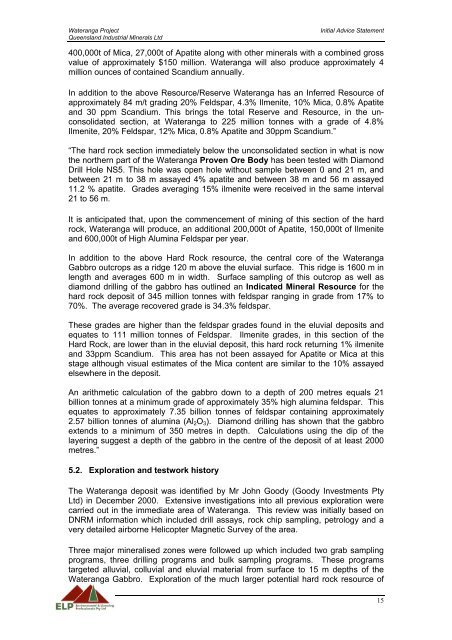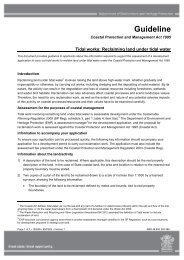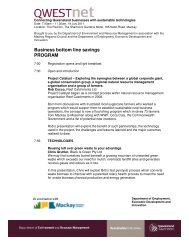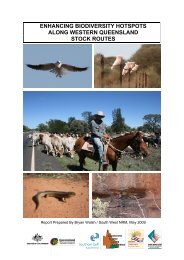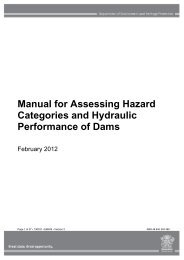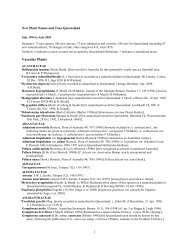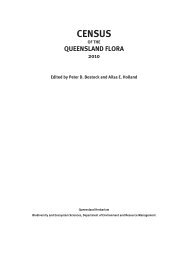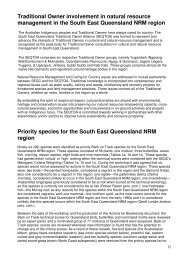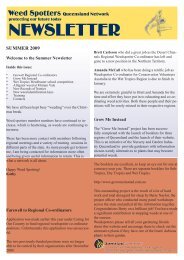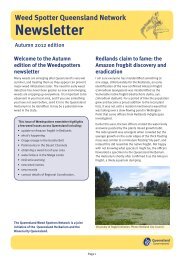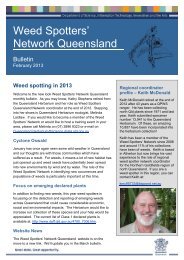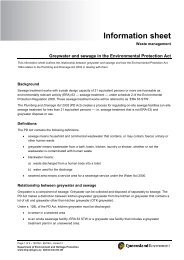WATERANGA PROJECT - Department of Environment and Heritage ...
WATERANGA PROJECT - Department of Environment and Heritage ...
WATERANGA PROJECT - Department of Environment and Heritage ...
You also want an ePaper? Increase the reach of your titles
YUMPU automatically turns print PDFs into web optimized ePapers that Google loves.
Wateranga Project Initial Advice Statement<br />
Queensl<strong>and</strong> Industrial Minerals Ltd<br />
400,000t <strong>of</strong> Mica, 27,000t <strong>of</strong> Apatite along with other minerals with a combined gross<br />
value <strong>of</strong> approximately $150 million. Wateranga will also produce approximately 4<br />
million ounces <strong>of</strong> contained Sc<strong>and</strong>ium annually.<br />
In addition to the above Resource/Reserve Wateranga has an Inferred Resource <strong>of</strong><br />
approximately 84 m/t grading 20% Feldspar, 4.3% Ilmenite, 10% Mica, 0.8% Apatite<br />
<strong>and</strong> 30 ppm Sc<strong>and</strong>ium. This brings the total Reserve <strong>and</strong> Resource, in the unconsolidated<br />
section, at Wateranga to 225 million tonnes with a grade <strong>of</strong> 4.8%<br />
Ilmenite, 20% Feldspar, 12% Mica, 0.8% Apatite <strong>and</strong> 30ppm Sc<strong>and</strong>ium.”<br />
“The hard rock section immediately below the unconsolidated section in what is now<br />
the northern part <strong>of</strong> the Wateranga Proven Ore Body has been tested with Diamond<br />
Drill Hole NS5. This hole was open hole without sample between 0 <strong>and</strong> 21 m, <strong>and</strong><br />
between 21 m to 38 m assayed 4% apatite <strong>and</strong> between 38 m <strong>and</strong> 56 m assayed<br />
11.2 % apatite. Grades averaging 15% ilmenite were received in the same interval<br />
21 to 56 m.<br />
It is anticipated that, upon the commencement <strong>of</strong> mining <strong>of</strong> this section <strong>of</strong> the hard<br />
rock, Wateranga will produce, an additional 200,000t <strong>of</strong> Apatite, 150,000t <strong>of</strong> Ilmenite<br />
<strong>and</strong> 600,000t <strong>of</strong> High Alumina Feldspar per year.<br />
In addition to the above Hard Rock resource, the central core <strong>of</strong> the Wateranga<br />
Gabbro outcrops as a ridge 120 m above the eluvial surface. This ridge is 1600 m in<br />
length <strong>and</strong> averages 600 m in width. Surface sampling <strong>of</strong> this outcrop as well as<br />
diamond drilling <strong>of</strong> the gabbro has outlined an Indicated Mineral Resource for the<br />
hard rock deposit <strong>of</strong> 345 million tonnes with feldspar ranging in grade from 17% to<br />
70%. The average recovered grade is 34.3% feldspar.<br />
These grades are higher than the feldspar grades found in the eluvial deposits <strong>and</strong><br />
equates to 111 million tonnes <strong>of</strong> Feldspar. Ilmenite grades, in this section <strong>of</strong> the<br />
Hard Rock, are lower than in the eluvial deposit, this hard rock returning 1% ilmenite<br />
<strong>and</strong> 33ppm Sc<strong>and</strong>ium. This area has not been assayed for Apatite or Mica at this<br />
stage although visual estimates <strong>of</strong> the Mica content are similar to the 10% assayed<br />
elsewhere in the deposit.<br />
An arithmetic calculation <strong>of</strong> the gabbro down to a depth <strong>of</strong> 200 metres equals 21<br />
billion tonnes at a minimum grade <strong>of</strong> approximately 35% high alumina feldspar. This<br />
equates to approximately 7.35 billion tonnes <strong>of</strong> feldspar containing approximately<br />
2.57 billion tonnes <strong>of</strong> alumina (Al2O3). Diamond drilling has shown that the gabbro<br />
extends to a minimum <strong>of</strong> 350 metres in depth. Calculations using the dip <strong>of</strong> the<br />
layering suggest a depth <strong>of</strong> the gabbro in the centre <strong>of</strong> the deposit <strong>of</strong> at least 2000<br />
metres.”<br />
5.2. Exploration <strong>and</strong> testwork history<br />
The Wateranga deposit was identified by Mr John Goody (Goody Investments Pty<br />
Ltd) in December 2000. Extensive investigations into all previous exploration were<br />
carried out in the immediate area <strong>of</strong> Wateranga. This review was initially based on<br />
DNRM information which included drill assays, rock chip sampling, petrology <strong>and</strong> a<br />
very detailed airborne Helicopter Magnetic Survey <strong>of</strong> the area.<br />
Three major mineralised zones were followed up which included two grab sampling<br />
programs, three drilling programs <strong>and</strong> bulk sampling programs. These programs<br />
targeted alluvial, colluvial <strong>and</strong> eluvial material from surface to 15 m depths <strong>of</strong> the<br />
Wateranga Gabbro. Exploration <strong>of</strong> the much larger potential hard rock resource <strong>of</strong><br />
15


